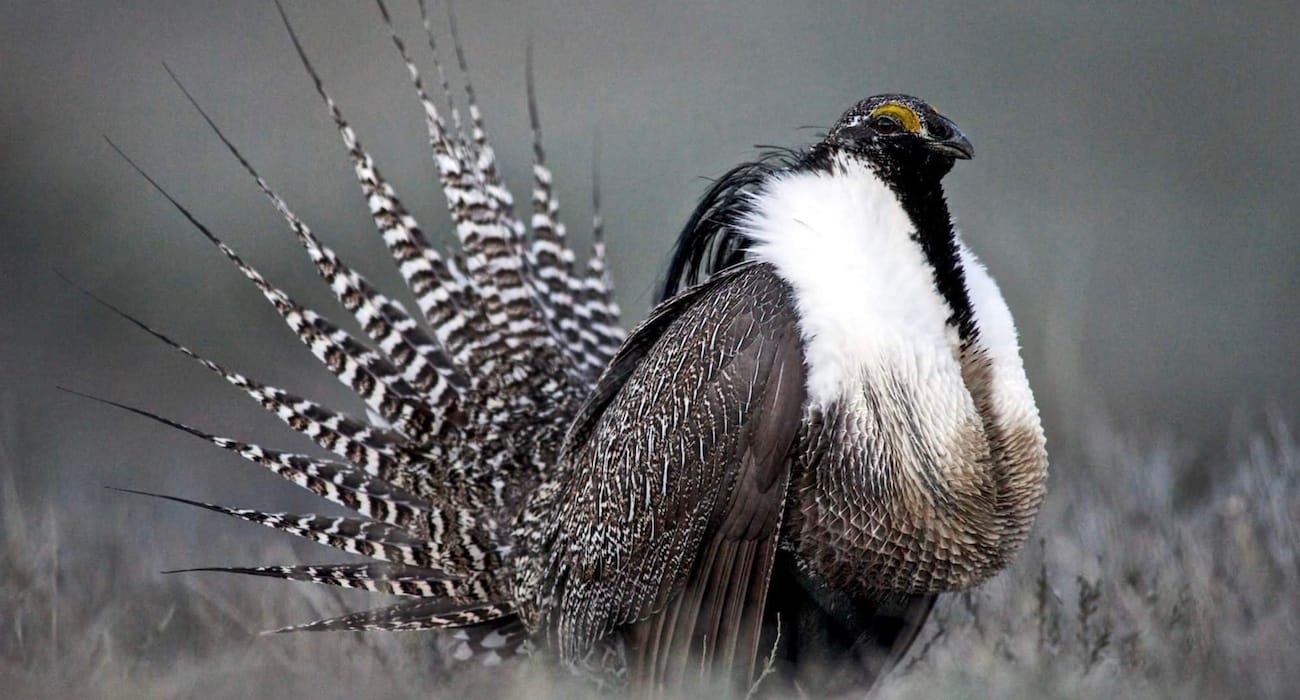Wyoming Sage Grouse Counts Fall Again, Marking a 5-year Trend

The more chemicals and pesticides we use, and the more we destock public ranges across the West, the more our treasured game birds decline. As usual, the “experts” blame climate change.
NOTE: this article was originally published to JHNewsandGuide.com on September 13, 2021. It was written by Angus M. Thuermer Jr.
Wyoming’s 2021 count of male greater sage grouse declined 13% compared to 2020, extending the downward trend of the troubled bird’s key population indicator to five years.
Wyoming Game and Fish Department released the spring count of males on breeding-ground leks Wednesday, revealing an average of 16.9 male grouse. The count is the lowest since 2013 when a phalanx of trained observers tallied an average of 16.8 males. In 1996 the number was 12.5, a nadir, according to Game and Fish Department data.
“The decline in lek attendance was expected for 2021 due to the sage grouse’s cyclical population trend and added drought conditions observed in Wyoming,” the Game and Fish Department said in a statement.
Wyoming is a stronghold for greater sage grouse in the West, holding an estimated 38% of the world’s population. The ground-dwelling, chicken-sized bird lives only in 11 states and two Canadian provinces.
The U.S. Fish and Wildlife Service in 2015 decided that protecting the greater sage grouse under the Endangered Species Act was “not warranted” based on conservation plans adopted by federal and state agencies across the West. Wyoming lek counts in 2021 are 54% of what they were in 2015.
Should state plans prove inadequate to reversing the trend, an Endangered Species Act listing could result. Associated federal restrictions, business and political leaders fear, would inhibit commercial activity in grouse habitat — much of the state — and be disproportionately detrimental to the Wyoming economy.
Wyoming has tracked grouse numbers for nearly 60 years and has seen the population rise and fall in a cyclical manner. Although some biologists dispute that concept, Game and Fish sagebrush and sage grouse biologist Leslie Schreiber said the recurrence happens regularly every six to eight years.
The population in the state hit an all-time low in the early 1990s, Game and Fish said, “following an extended drought and loss of habitat.”
Wyoming has greatly altered its hunting seasons to protect greater sage grouse, starting the season later, limiting the number of birds that can be shot in a day, limiting the number of birds a hunter can possess and closing some areas.
A gubernatorial executive order limiting development in sagebrush country seeks to keep habitat intact. The governor’s Sage Grouse Implementation Team works to implement that order, separate from, but associated with, the Wyoming Game and Fish Department.
Hunting begins in some areas Sept. 18. Closing dates vary.
The Game and Fish department saw the dip coming, Schreiber said in a statement.
“When considering the sage grouse’s population cycle, we look at the number of chicks per hen,” she said, drawing that data from hunter-submitted wings from birds they kill each fall.
“Game and Fish estimated an average of 1.1 chicks per hen in 2020,” she said in a statement. “[F]or the population to grow, the average needs to be closer to 1.5 chicks per hen.”
Because of drought, “habitat projects that keep water on the landscape will be a priority in the coming years,” Schreiber said in her statement. “Sage grouse cannot thrive if the sagebrush habitat is fragmented and in poor condition which is why Wyoming engages in significant efforts to conserve sage grouse and build resiliency in the ecosystem.”
Weather and climate — impacting food and cover — are factors weighing on greater sage grouse survival and are thought to be contributing to the rise and fall of grouse numbers. The actual cause, however, “is not understood,” the Game and Fish department said.
All told, observers tallied more than 15,800 strutting males in 2021.
Some biologists believe there are twice as many hens as cocks on the leks each spring. One researcher recently recommended that Wyoming adopt a permit system for hunting grouse to better track numbers.
